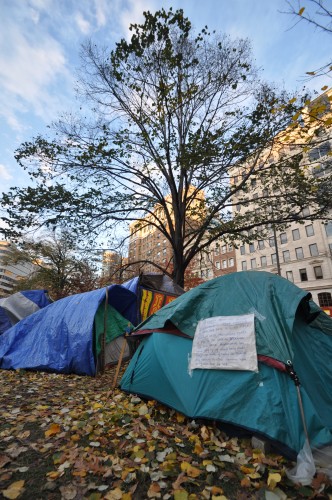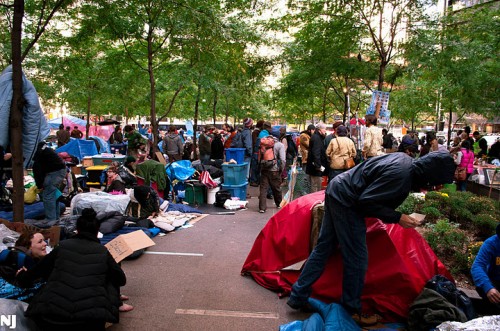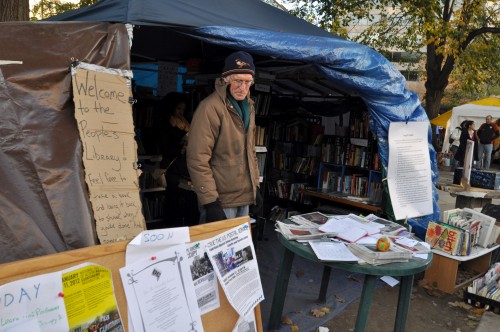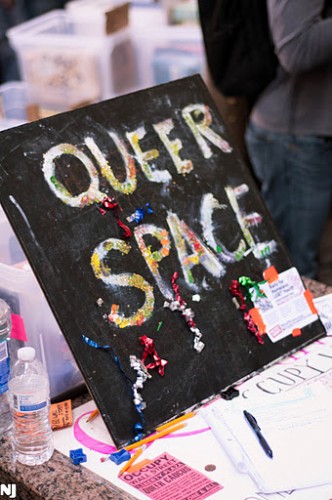
After the many, many evictions which have taken place over the last several weeks, both here in Canada and in the United States, there has been a lot of discussion about the ‘next phase’ of the Occupy movement. My personal interest has been focused, from the start, on the specific instance of the New York occupation, so it is their eviction and current situation which interests me the most. I specify this up front because I think it is difficult to speak about the OWS movement as a Whole in meaningful terms, since each occupation is so localized. I like the comparison to open-source projects for this: some useful generalizations are possible, but the source code is open to tinkering and adapted to each specific use.
Recently, the NY Occupation was evicted from their previous home at Liberty park, and scattered to the four winds. They have so far proven that they have the institutional robustness to deal with this by continuing to provide food and shelter to all in need, as well as continuing to effectively plan and implement direct actions along with effective media. They have even continued their regularly scheduled General Assemblies and Spokes Councils, despite cold weather, a hard time finding space, and what seem to be increasing feelings of tension amongst certain committed members.
I see this continued ability to act as centrally linked to their being an Augmented Movement. Because they represent this blend of atoms and bits they have been able to continue coordinating effectively by transferring ever more of that coordination online. However, as an augmented movement, they face unique problems. Bits are well and good, but atoms are tricky things, and certain things can only continue to happen offline: people need food and places to stay, as well as the need to meet and communicate face to face so that strong links can be maintained along with the horizontal institutions upon which the current movement is premised. It is this second aspect of their problem which I find most interesting, and challenging.

On this site it has been argued that the lack of a central space, the Camp, might serve to move the Occupy movement onto a new level. One based ‘more on message than on camping’, as it were. Specifically that it will still be possible for the movement to Occupy the national dialogue, or the media, and to work together across their multiple sites to maintain prominence in both discourse and news.
Now, this is all well and good, and I agree wholeheartedly! The movement, in terms of its message and ability to be heard, is not necessarily threatened by moving the preponderance of its presence online. In effect, their informational presence is not threatened by an attack on their physical location, however this shift away from their physical manifestation still risks to fundamentally alter the dynamics of the movement if allowed to occur. The movement’s sense of place, of community, and many of its most radical principles and practices are threatened by this attack on their physical self, because the Camp existed as more than simply a symbolic protest action.
This movement was predicated on actively embodying the change which its proponents wanted to see in their society. These camps were the physical manifestation of their values, and provided much more than a base for planning. They were a home, a real Place where the heart of the movement could be found, and somewhere where anybody could go and get access to it. It provided a public space for discourse, for the creation of a collective will, and for providing all the things which people knew were lacking from the system set up outside the park. As much as their online presence can be described in terms of place, and access, this was just as true before the eviction. However a movement away from physical space, and into the web, only serves to limit accessibility along the lines of a digital divide: for those who depended on a physical presence to get access to the movement, that access is now being cut off.

I see the General Assembly as emblematic of this shift. Here is an earnest attempt at a direct participatory democracy which was given sovereignty over the actions of the movement itself. Having a physical space, a home, where it could be based was an important embodiment of its openness. Anyone could come to the park and be a member, could speak up, ask questions, and vote. It was accessible because it had that regularity, and democratic institutions like these need to have regularity to accomplish their goals.
After the eviction, while reading the minutes from the GAs and the Spokes Council, I see that people are in disarray. Gatherings are small, people are falling out of synch because they are no longer able to be in contact as frequently, and I see complaints that the meetings are harder to know about these days. These are the symptoms of a democratic institution which is losing its Place, formalizing and shrinking, because it is no longer the common expression of a People in the same way it was when they Lived alongside it.
Because this is a truly augmented movement, it is not enough for it to merely exist online and periodically manifest itself in physical space. If it is reduced to that, it will be a fundamentally different movement. I’m sure GAs can keep going on, and Spokes Councils along with them. People will coordinate, make decisions, take action. But it will truly have been reduced. Without a consistent physical space, one which is a home to the movement, its Public nature will change. Its openness will suffer, and I think that its most radically democratic elements are at risk of becoming little more than organizational tools once more.

It was always the physical aspect of the encampment which was most threatening. The pudding. Proof that alternate means of collective organizing are possible. The system wants to split that, to strip the informational aspect (the message) away from its more threatening physical manifestation. I fear that, without an Occupation, its really only just a movement.
Gene is an undergraduate student studying political science in Montreal, but is primarily interested in the effect of information technology on collective action. Follow him on Twitter @replqwtil.

Comments 2
Occupy, Space, and the Symbolic Power of a Tent » Cyborgology — December 5, 2011
[...] me to my second point, and the one on which I want to focus here: Occupy encampments are not only physical centers and anchorpoints for the larger Occupy movement, but are also both implicitly and explicitly physical embodiments of a particular set of [...]
The OWS mega-post ‹ Phire Walk With Me — December 5, 2011
[...] history of the OWS protests, while The Society Pages provides an eloquent analysis about why the eviction may have been a good thing in terms of galvanizing the movement onto the next phase. And finally, perhaps fittingly, New [...]